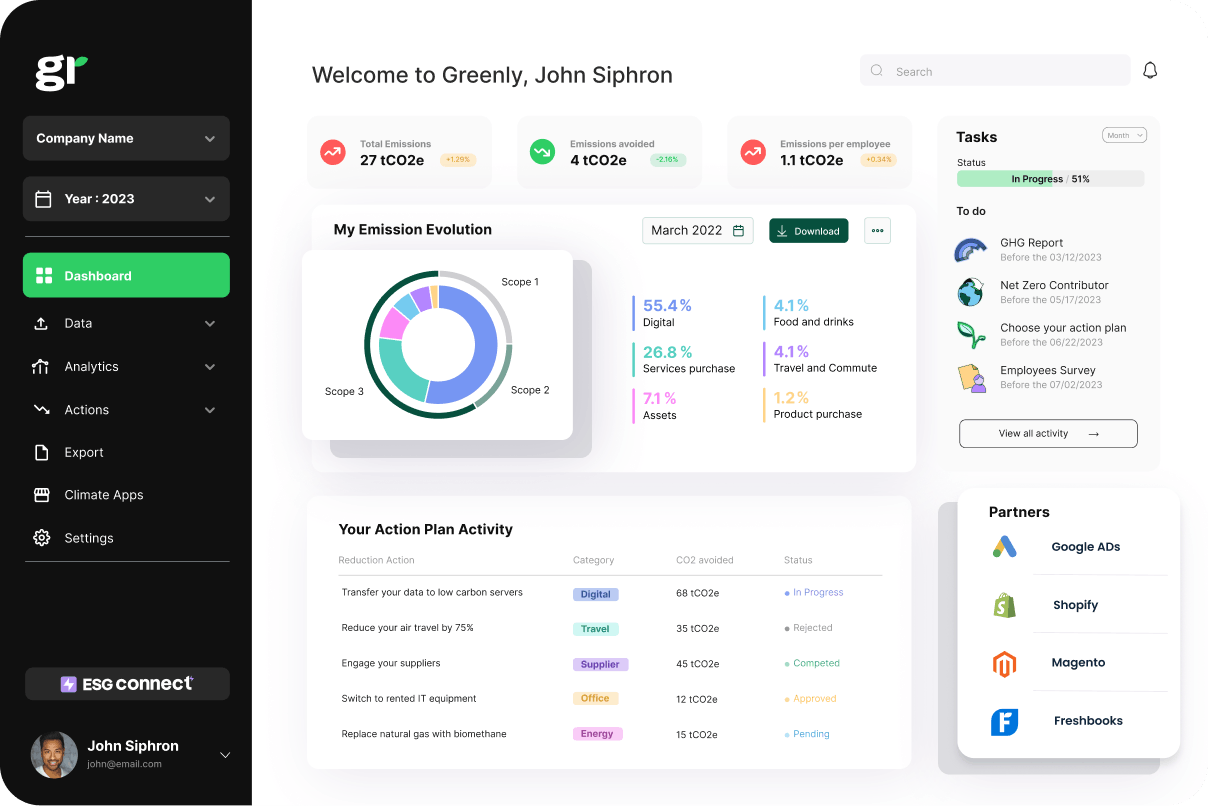
California Climate Accountability Package: SB253, SB261, & SB252
What is the California Climate Accountability Package, and how do SB 253 and SB 261 (SB 219), and SB 252 help the state work towards their environmental goals?
ESG / CSR
Industries



CO2e, or carbon dioxide equivalent, is a standardized unit used to measure the climate impact of various greenhouse gases. While carbon dioxide (CO2) is the most commonly referenced greenhouse gas, it’s not the only one contributing to global warming. Other gases, such as methane (CH4) and nitrous oxide (N2O), have a much higher warming potential than CO2, making it difficult to compare their effects on the climate. CO2e solves this by providing a way to express the impact of different greenhouse gases using a single, comparable metric.
Whether you’re reading a corporate sustainability report, assessing your personal carbon footprint, or reviewing climate policy targets, you’re likely to encounter CO2e. But how exactly is it calculated, and why is it such a crucial tool in the fight against climate change?
👉 In this article, we'll explore what CO2e is, how it’s calculated, and why it plays a key role in emissions reporting and sustainability efforts.
CO2e, or carbon dioxide equivalent, is a metric used to standardize the measurement of greenhouse gas emissions. It provides a common unit that allows different gases to be compared based on their global warming potential (GWP). This standardization makes it easier to assess the overall climate impact of various activities, products, or even entire organizations.
At its core, CO2e reflects the amount of carbon dioxide (CO2) that would create the same level of global warming as the measured greenhouse gas emissions. Since different gases have varying heat-trapping abilities and atmospheric lifespans, CO2e simplifies these differences into a single, comparable figure.
For example, methane (CH4) is far more potent than CO2 in the short term, with a GWP over 80 times higher over a 20-year period. Nitrous oxide (N2O) is also significantly more powerful, with a GWP around 273 times greater over a century. CO2e helps balance these variations by converting emissions of different gases into the equivalent amount of CO2 emissions.
By using CO2e, businesses, policymakers, and individuals can more accurately assess the climate impact of their activities, track progress toward sustainability goals, and make informed decisions on emissions reduction strategies.
CO2e was developed to address the challenge of comparing the climate impact of different greenhouse gases. While carbon dioxide (CO2) is the most prevalent greenhouse gas, other gases like methane (CH4) and nitrous oxide (N2O) have significantly higher global warming potentials (GWP) despite being emitted in smaller quantities. Without a standardized measurement system, it would be difficult to assess the combined climate impact of multiple gases or compare emissions across industries and regions.
The concept of CO2e was introduced to simplify climate accounting by expressing all greenhouse gas emissions using a single, comparable metric based on their global warming potential. The GWP of a gas measures how much heat it traps in the atmosphere over a specified period, typically 100 years, compared to carbon dioxide. For example, methane has a GWP of around 80 over 20 years, while carbon dioxide has a GWP of 1, making CO2 the baseline for comparison.
CO2e plays a critical role in:
CO2e is calculated by multiplying the quantity of a greenhouse gas emitted by its global warming potential (GWP). This formula allows different greenhouse gases to be expressed in terms of their equivalent impact compared to carbon dioxide.
The basic formula for CO2e calculation:
CO2e = Quantity of GHG emitted (kg) × GWP of the gas
GWP is a measure of how much heat a greenhouse gas traps in the atmosphere compared to carbon dioxide over a specific time period, typically 100 years. CO2 has a GWP of 1, serving as the baseline, while other gases have higher values due to their greater heat-trapping abilities.
For example:
Example of CO2e calculation:
Imagine a company emits the following greenhouse gases:
Step 1: Convert each gas using its GWP (based on a 100-year period):
Step 2: Add the results together:
1,000 + 2,800 + 13,650 = 17,450 kg CO2e
This total represents the combined climate impact of all the gases emitted, expressed as a single figure in CO2e.
By standardizing the way emissions are measured, CO2e makes it easier for businesses and policymakers to identify which activities have the greatest climate impact and where efforts should be focused for reduction.
CO2e provides a standardized way to compare the climate impact of various greenhouse gases based on their global warming potential (GWP). While carbon dioxide (CO2) is the most commonly emitted greenhouse gas, there are others that contribute significantly to global warming and are factored into CO2e calculations.
| Greenhouse Gas | Global Warming Potential (GWP) | Primary Sources |
|---|---|---|
| Carbon dioxide (CO2) | 1 (baseline) | Burning fossil fuels, deforestation, industry |
| Methane (CH4) | 28-80 | Agriculture (livestock), landfill, gas leaks |
| Nitrous oxide (N2O) | 273 | Fertilizer use, industrial activities, fuels |
| Hydrofluorocarbons (HFCs) | Up to 12,400 | Refrigeration, air conditioning |
| Perfluorocarbons (PFCs) | Up to 12,200 | Aluminum production, semiconductor manufacturing |
| Sulfur hexafluoride (SF6) | 25,200 | Electrical insulation, magnesium processing |
| Nitrogen trifluoride (NF3) | 17,200 | Semiconductor manufacturing |
Each greenhouse gas varies in its ability to trap heat and its lifespan in the atmosphere. For example:
By converting all greenhouse gases into a single CO2e figure, climate impact assessments become more consistent and comparable, helping businesses and policymakers set clearer reduction targets and track progress.
CO2e plays a critical role in measuring and managing greenhouse gas emissions, making it a cornerstone of global climate action efforts. By providing a standardized metric, it allows businesses, policymakers, and individuals to assess and compare the climate impact of different activities, products, and industries more effectively.
Here’s why CO2e is so essential:
While CO2e is a widely used metric for standardizing greenhouse gas emissions, it has several limitations that can affect how climate impact is measured and understood. Recognizing these limitations is essential for ensuring emissions data is used responsibly and interpreted accurately.
1. Oversimplification of climate impact
CO2e reduces the complexity of multiple greenhouse gases into a single figure, which can sometimes oversimplify the true environmental impact. Different gases behave differently in the atmosphere; some trap heat more effectively but for shorter durations, while others persist for centuries. For example:
This reduction into a single metric can obscure the varying timelines and effects of different gases.
2. Uncertainty in Global Warming Potential (GWP) estimates
The GWP values used in CO2e calculations are based on scientific models, which can change over time as climate science evolves. For example, methane’s GWP can differ depending on whether a 20-year or 100-year timescale is used, leading to variations in reported CO2e values.
3. Timeframe sensitivity
CO2e calculations are typically based on a 100-year GWP timeframe, which may not accurately reflect the short-term climate effects of potent gases like methane. This can lead to an underestimation of the immediate impact of some emissions, especially in regions focused on short-term climate action.
4. Potential for misuse in offsetting claims
CO2e is often used in carbon offsetting and neutrality claims, which can be misleading. Since CO2e aggregates all greenhouse gases into a single figure, companies may focus on balancing emissions through offsetting rather than prioritizing direct reductions. As a result, some offsetting strategies may give a false impression of climate progress.
5. Exclusion of non-GHG climate impacts
CO2e focuses only on greenhouse gases and excludes other climate-impacting factors such as land use changes, deforestation, and aerosol pollution, which can also influence global temperatures.
Key takeaway:
While CO2e is a valuable tool for standardizing emissions reporting, it should be used alongside more comprehensive climate assessments. Acknowledging its limitations helps ensure the metric supports genuine emissions reductions rather than acting as a simplified climate accounting shortcut.
Greenly offers expert carbon management solutions to help businesses accurately measure, analyze, and reduce their CO2e emissions, supporting a more sustainable future.
Our services include:
By offering transparent emissions data and actionable insights, Greenly empowers businesses to make informed decisions that contribute meaningfully to global sustainability efforts. Get in touch with us today to find out more.
